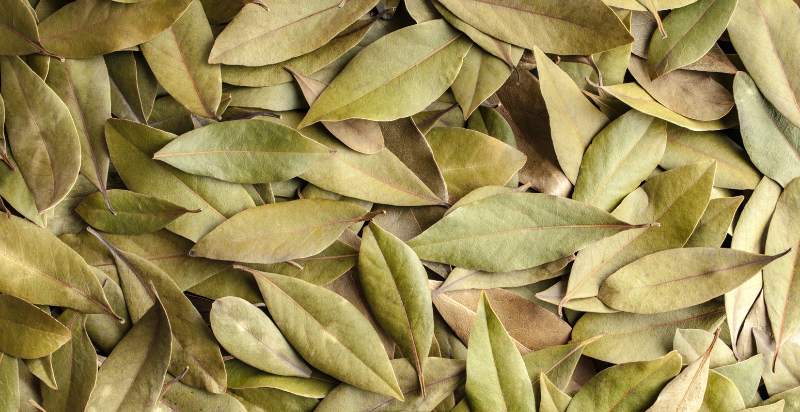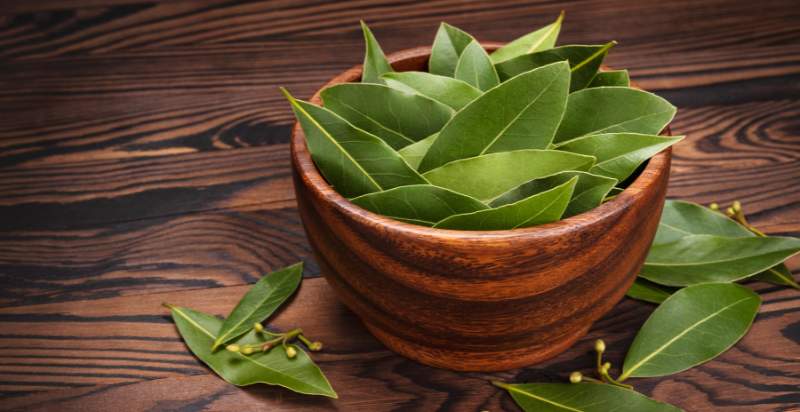Bay leaves are aromatic herbs used in cooking and medicine for centuries. They come from the evergreen bay laurel tree, native to the Mediterranean region. It flavor soups, stews, sauces, and other dishes. In addition, they’re believed to have many health benefits. Here is everything wanted to know about Bay leaves:
Description / Taste:
Bay leaves have a strong, pungent aroma and taste reminiscent of eucalyptus, mint, and oregano. They are oval-shaped with a sharp point at one end. Fresh leaves are bright green, while dried bay leaves are dark green to almost black.
Seasons / Availability:
Fresh bay leaves are available year-round, while dried bay leaves may be found in markets or online specialty stores.

Geography / History:
Bay leaves have been used since ancient times and are believed to have originated in the Mediterranean region. It continues to be a popular ingredient in many cultures, particularly in countries such as Turkey and Greece.
Applications of Bay Leaves:
Bay leaves are usually used whole and added to dishes while cooking. They can be removed before serving or left in for a more intense flavor. It may also be ground into a powder and used as a seasoning. Additionally, they have been used medicinally for their anti-inflammatory properties and are believed to help with digestive issues, heart health, and even pain relief.
Nutrition Values of Bay Leaves:
Bay leaves are a good source of vitamins A, C, and K, calcium, and iron. They also contain polyphenol compounds that have antioxidant properties.
Storage:
Fresh bay leaves should be stored in the refrigerator in an airtight container for up to one week. Dried bay leaves can be stored in an airtight container or jar at room temperature for up to six months.
Tips:
When using bay leaves, remember that a little goes a long way. Too much can overpower the flavor of dishes, so use them sparingly. They should also be removed from dishes before serving since they are not meant to be eaten. Lastly, these leaves have a stronger flavor when dried than fresh, so adjust the recipe accordingly.
Safety:
Bay leaves can cause digestive problems if eaten in large quantities and may contain toxic compounds harmful to humans if consumed excessively. It is best to use them in small amounts and remove them from dishes before serving.
Nutritional Content of Bay Leaves:
Bay leaves are a good source of several vitamins and minerals, including vitamins A and C, magnesium, copper, iron, and calcium. They also provide dietary fiber and small amounts of essential fatty acids. It contain antioxidants such as polyphenols which can help protect cells from oxidative damage caused by free radicals.
Health Benefits:
Consuming bay leaves may improve digestion, reduce inflammation, and control blood sugar. They may even help lower cholesterol levels. Additionally, these leaves may help fight infections, protect against cancer, and boost the immune system.

How to Use Bay Leaves?
Bay leaves are usually added to recipes in a dried form, either whole or ground into powder. They have a strong aroma, so it’s best to use them sparingly. It’s also important to note that these leaves should be removed from dishes before serving as they can be sharp and difficult to digest if eaten whole.
When buying bay leaves, look for those with a greenish-gray color, as they tend to be more aromatic than lighter-colored varieties. Store dried bay leaves in an airtight container away from direct sunlight.
Conclusion:
Bay leaves are an aromatic, flavorful, and nutritious addition to various recipes. They also provide many potential health benefits, such as improved digestion, reduced inflammation, and better blood sugar control. When using these leaves in cooking, remove them before serving as they can be sharp and difficult to digest if eaten whole. With proper storage, dried bay leaves can last for several years.
- Everything You Wanted to Know About Red Tamarillos - June 2, 2025
- A Guide to Tulips: Everything You Need to Know & More… - June 2, 2025
- Guanabana: Description, Flavor, Benefits, And Uses - May 27, 2025

3 thoughts on “Bay Leaves: Description, Flavor, Benefits, And Uses ”
Comments are closed.